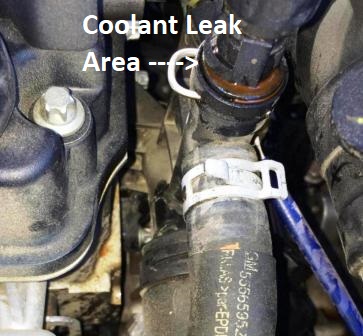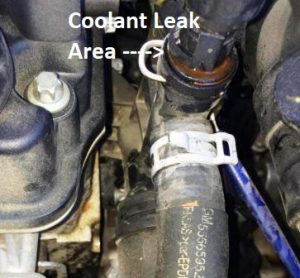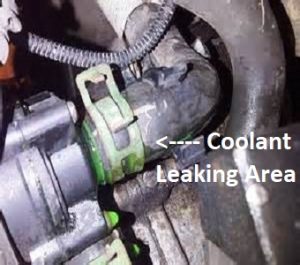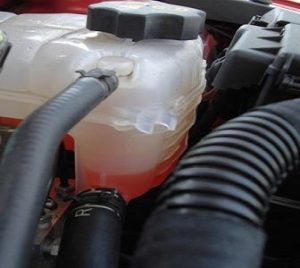

Back in the day, common coolant leak problems included water pump and radiator leaks. Although these problems still exist on modern automobiles the list of possible root causes has increased exponentially. Personally, I blame the overuse of plastic materials in the engine compartment. However, since we need to consider the usual suspects along with the new wave of possible coolant leaks, it’s time to discuss pinpoint diagnosis and repair of common coolant leak problems.
One area that we won’t dive into is the radiator. Our sister site covered this well in an article that outlines how to deal with automotive radiator problems. Nevertheless, we will cover early warning signs and symptoms of a leaking antifreeze situation.
Unfortunately, these leaks often begin, so slowly that we never actually see engine coolant hitting the ground. A puddle of coolant underneath your car when you pull away from a parking space use to be the easiest way to know you had a problem. On some of these modern automobiles the leak begins so slow that it evaporates or burns off on the hot engine. In these situations we depend on the other symptoms common to a low engine coolant scenario.
Symptoms of Coolant Leak Problems

The first sign of trouble when you’re car develops a coolant leak problem often depends on its year, make and model. In the last section we’ll show you how to use this information to find problems with your car. With that said, we can still cover common symptoms associated with low antifreeze. Drivers should be familiar with the sounds and smells associated with coolant leaks.
They pressurized the coolant system to 15 psi. This reduces the boiling point, allowing the motor to run at hotter temperatures. Higher temperature reduces engine sludge buildup. In order for the system to operate properly, it must remain filled at all times and without the presence of air. When the coolant system becomes low it allows air to infiltrate. These pockets of air form bubbles that circulate through the system. One of the common complaints of a low coolant situation is a gurgling sound heard inside the automobile.
This gurgling sound becomes the previously mentioned air bubbles passing through the heater core. Of course, if the driver listens to the radio this symptom can go unnoticed. So here’s the next symptom of a coolant leak. As the level continues to decrease more air circulates throughout. Eventually the system becomes air bound. This is a situation where air and pressurized antifreeze fight each other and reduce the efficiency of coolant circulation.
In this scenario the engine might not run hot enough to illuminate the overheat warning indicator. However, the heater core remains vulnerable at becoming air bound. This means antifreeze will no longer flow through the heater core or warm the passenger compartment. Therefore, another common symptom of coolant leak problems becomes the lack of heat. Finally, we have the unique aroma of coolant burning on a warm engine. Drivers often get whiffs of a sweet smelling steam. This unique odor becomes an indication of a coolant leak issue.
Areas Known for Leaking Coolant

On older automobiles it’s still quite possible to find leaks in likely areas. One of these locations we covered in a separate article about failure of the radiator hoses. Staying in the old-school coolant leak category let’s talk a little bit about the water pump. They designed an automotive water pump to last about 15 years or 150,000 miles. This is just an approximation.
However, the general public drives their automobiles much further than they used to years ago. In fact, 15 years and 150,000 miles come quickly in the ownership cycle of the average vehicle. Therefore, careful inspection of the water pump should be high on the visual inspection list. At the base of the input shaft, driven by [[the engine drive belt]], you’ll still find an inspection orifice fondly nicknamed the weep hole.
As the water pump begins to wear you develop play in the input shaft and the pump begins to wobble as it operates. This movement, then in turn damages the input shaft seal. When this happens, dribbles of coolant escape through the leaking seal and out of the weep hole. Slight leakage from this area is notoriously known for not hitting the ground. This is because the water pumps location allows the coolant to dribble down the hottest parts of the engine. The coolant evaporates instead of dripping on the ground to notify the driver of an issue.
A New Generation of Coolant Leaks

We see a lot more plastics in the engine compartment today than ever before. Now we’re heading down the path to see how thin and light we can make these plastic parts. I compare this process to the 16 ounce bottle of water. Just 10 years ago, bottled water came in a substantial container. They continued to thin these down until you can barely pick one up without it crumbling in your hand now.
In the same manner automotive manufacturers are making some thin plastic parts to carry engine coolant. As a mechanic I’ve seen common coolant leak problems where plastic fittings attach between the engine and the antifreeze overflow bottle. I see it a lot on the newer Chevrolet Malibu. However, I fixed the same problem on a wide variety of popular automobiles including Kia and Hyundai model cars and trucks.
Why? The coolant reservoir mounts to the stationary firewall while the engine side of the hose vibrates and moves. This situation causes coolant leak problems that the vehicle manufacturer should have seen coming. In the same way, engine designers, mounted plastic coolant carrying components directly to the engine block. Not surprisingly, this becomes another area that often leaks. As an example, the Chevy Cruze leaks coolant from the thermostat housing where it attaches to the water jacket on the engine block.
Where to Find Coolant Leak Information
When a problem becomes widespread the manufacturer issues a technical service bulletin. Although this remains a notification for in-house dealership technicians of common problems, the information quickly spreads across the Internet. Finally, the National Highway and Traffic Safety Administration become aware of these common car problems and list them in the NHTSA database.




